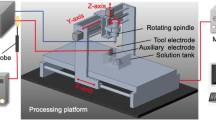Abstract
Experimental investigations into the effect of duty cycle and electrolyte concentration on the surface topography in the microchannel formation in the soda-lime glass substrate by a pulsed electrochemical discharge machining are reported. These microstructures are required in various microsystems applications such as microfluidics, integrated-passive-devices for radio-frequency MEMS, 3-D glass interposer. No significant machining happened at lower duty cycles (< 50%) and lower electrolyte concentration (10%), which was due to the lower surface temperature generated as predicted by the numerical simulation. At these parameters, the tool electrode locally adhered to the glass substrate and prevented the underneath glass surface from being etched periodically. The non-homogeneous etching leads to the uneven surface topography and pillar-like structures, which is termed as the ‘localized adhesion and fast releasing effect. It was observed to be severe when the tool electrode was in contact with the glass substrate, i.e., zero-gap. At this condition, high temperature led to the thermal expansion of the tool electrode, which resulted in the intermittent machining and pillar-like structures in the middle of the microchannel. As the gap was increased, this effect was subsidized, and the surface topography of microchannel improved. Variation in microchannel depth and heat-affected zone (HAZ) at various electrolyte concentrations and duty cycles were investigated. Experimental results revealed that the microchannel depth and the HAZ increase with an increase in the duty cycle and electrolyte concentration. Deeper microchannels (> 500 µm) having complex shapes were demonstrated by using a multi-pass milling technique. The capability of the presented method in making buried redistribution lines in 3D MEMS inductor is also shown.












Similar content being viewed by others
References
Arab J, Mishra DK, Kannojia HK et al (2019) Fabrication of multiple through-holes in non-conductive materials by electrochemical discharge machining for RF MEMS packaging. J Mater Process Technol 271:542–553
Hajian M, Razfar MR, Movahed S (2016) An experimental study on the effect of magnetic field orientations and electrolyte concentrations on ECDM milling performance of glass. Precis Eng 45:322–331
Hajian M, Razfar MR, Etefagh AH (2017) Experimental study of tool bending force and feed rate in ECDM milling. Int J Adv Manuf Technol 91:1677–1687
Han M, Chae KW, Min B (2017) Fabrication of high-aspect-ratio microgrooves using an electrochemical discharge micromilling process. J Micromech Microeng 27:055004
Huang L, Cao Y, Jia F, Lei Y (2019) Study on the stability of gas film in electrochemical discharge machining of ultra-white glass micro array holes. Microsyst Technol. https://doi.org/10.1007/s00542-019-04623-9
Iliescu C, Chen B (2007) Thick and low-stress PECVD amorphous silicon for MEMS applications. J Micromech Microeng 18:15024
Iliescu C, Chen B, Miao J (2008) On the wet etching of Pyrex glass. Sens Actuat A Phys 143:154–161
Jui SK, Kamaraj AB, Sundaram MM (2013) High aspect ratio micromachining of glass by electrochemical discharge machining (ECDM). J Manuf Process 15:460–466
Kannojia HK, Arab J, Pegu BJ, Dixit P (2019) Fabrication and characterization of through-glass vias by the ECDM process. J Electrochem Soc 166:D531–D538
Kolari K, Saarela V, Franssila S (2008) Deep plasma etching of glass for fluidic devices with different mask materials. J Micromech Microeng 18:64010
Liu Y, Zhang C, Li S et al (2019) Experimental study of micro electrochemical discharge machining of ultra-clear glass with a rotating helical tool. Processes 7:195
Mishra DK, Arab J, Magar Y, Dixit P (2019a) High aspect ratio glass micromachining by multi-pass electrochemical discharge based micromilling technique. ECS J Solid State Sci Technol 8:P322–P331
Mishra DK, Verma AK, Arab J et al (2019b) Numerical and experimental investigations into microchannel formation in glass substrate using electrochemical discharge machining. J Micromech Microeng 29:75004
Patro SK, Mishra DK, Arab J, Dixit P (2020) Numerical and experimental analysis of high-aspect-ratio micro-tool electrode fabrication using controlled electrochemical machining. J Appl Electrochem 50:169–184. https://doi.org/10.1007/s10800-019-01380-5
Sabahi N, Razfar MR (2018) Investigating the effect of mixed alkaline electrolyte (NaOH + KOH) on the improvement of machining efficiency in 2D electrochemical discharge machining (ECDM). Int J Adv Manuf Technol 95:643–657
Sabahi N, Hajian M, Razfar MR (2018) Experimental study on the heat-affected zone of glass substrate machined by electrochemical discharge machining (ECDM) process. Int J Adv Manuf Technol 97:1557–1564
Saranya S, Nair A, Sankar AR (2017) Experimental investigations on the electrical and 2D-machining characteristics of an electrochemical discharge machining (ECDM) process. Microsyst Technol 23:1453–1461
Zhang Z, Huang L, Jiang Y et al (2016) A study to explore the properties of electrochemical discharge effect based on pulse power supply. Int J Adv Manuf Technol 85:2107–2114
Zheng Z-P, Cheng W-H, Huang F-Y, Yan B-H (2007) 3D microstructuring of Pyrex glass using the electrochemical discharge machining process. J Micromech Microeng 17:960
Ziki JDA, Didar TF, Wüthrich R (2012) Micro-texturing channel surfaces on glass with spark assisted chemical engraving. Int J Mach Tools Manuf 57:66–72
Acknowledgements
The authors would like to acknowledge the financial support from the Ministry of Human Resources and Development (MHRD) and the Department of Scientific and Industrial Research (DSIR) through (DSIR/PACE/TDD-IMPRINT/7510). This work has been carried out as a part of the Impacting Research Innovation and Technology (Imprint) Project, initiated by MHRD, Government of India, under the research Grant 10007457.
Author information
Authors and Affiliations
Corresponding author
Additional information
Publisher's Note
Springer Nature remains neutral with regard to jurisdictional claims in published maps and institutional affiliations.
Rights and permissions
About this article
Cite this article
Verma, A.K., Mishra, D.K., Pawar, K. et al. Investigations into surface topography of glass microfeatures formed by pulsed electrochemical discharge milling for microsystem applications. Microsyst Technol 26, 2105–2116 (2020). https://doi.org/10.1007/s00542-020-04770-4
Received:
Accepted:
Published:
Issue Date:
DOI: https://doi.org/10.1007/s00542-020-04770-4



